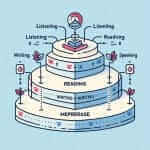Multiple choice questions are a common feature in the IELTS exam, appearing in the Listening, Reading, and even occasionally in the Grammar sections. While they may seem straightforward, they can be surprisingly tricky. This article will delve into effective strategies to help you confidently tackle multiple choice questions and boost your IELTS score.
Understanding Multiple Choice Questions in IELTS
Multiple choice questions typically present a question or an incomplete statement followed by a list of options, usually labelled A, B, C, and D. Your task is to select the best answer from the given choices.
Strategies for Success
Here are proven tactics to improve your performance on IELTS multiple choice questions:
1. Read the Question Carefully
It might sound obvious, but rushing through the question is a common mistake. Pay close attention to what the question is actually asking. Identify keywords and phrases that indicate the focus of the question.
Example:
What is the MAIN reason the author mentions the Industrial Revolution?
- In this case, you are not looking for any mention of the Industrial Revolution, but specifically the main reason the author brings it up.
2. Scan for Keywords
Before diving into the answer choices, quickly scan the passage or listen attentively to the audio (in the Listening test) for keywords related to the question. This will help you locate the relevant information quickly.
3. Eliminate Obvious Distractors
Often, some answer choices are designed to seem plausible but are ultimately incorrect. Practice identifying distractors. These options might contain information from the passage but not directly answer the question, or they might include slight inaccuracies.
Example:
Passage: The Great Barrier Reef suffers from coral bleaching due to rising sea temperatures.
Question: What is the primary threat to the Great Barrier Reef?
- A) Pollution (Distractor – a potential threat, but the passage focuses on rising sea temperatures)
- B) Tourism (Distractor – a possible concern, but not mentioned in the passage)
- C) Rising sea temperatures (Correct – directly stated in the passage)
- D) Overfishing (Distractor – a valid concern for marine ecosystems but not the focus here)
4. Paraphrasing is Key
The correct answer is often a paraphrase of the information provided in the passage or audio. Look for options that express the same idea using different words.
5. Don’t Overthink
Avoid overanalyzing or reading too much into the answer choices. If an option seems to fit directly with the information provided, it is likely correct. Don’t search for hidden meanings or overly complex interpretations.
6. Manage Your Time
Keep an eye on the clock. Don’t spend too much time on a single question. If you’re unsure, make your best guess and move on. You can always come back to it if you have time left at the end.
Applying the Strategies: IELTS Practice
Let’s apply these strategies to a real IELTS Listening Section example:
You will hear a conversation between two friends, Sarah and David, about their recent holiday experiences.
Question: What did David enjoy most about his trip to Italy?
- A) The historical sites
- B) The local cuisine
- C) The sunny weather
- D) The friendly locals
Audio Script:
Sarah: So, how was Italy?
David: It was amazing! I loved exploring the Colosseum and the Trevi Fountain. But honestly, the food was the highlight for me. The pasta, the pizza, the gelato – it was incredible!
Analysis:
- Keyword: “enjoyed most”
- Eliminate Distractors: While David mentions historical sites (A), the focus of his enthusiasm is the food.
- Paraphrasing: David uses words like “highlight” and “incredible” to express his enjoyment of the food, which aligns with option (B).
Therefore, the correct answer is (B).
 IELTS Multiple Choice Example
IELTS Multiple Choice Example
Common Mistakes to Avoid
- Rushing through questions: Take your time to understand what is being asked.
- Not reading all answer choices carefully: Even if you think you’ve found the right answer, read all options to ensure you’ve chosen the best one.
- Ignoring keywords: Keywords provide crucial clues about the information you need to locate.
- Overthinking: Choose the answer that most directly aligns with the information provided, without overanalyzing.
Practice Makes Perfect
The key to mastering multiple choice questions is practice. Utilize IELTS practice tests and work through sample questions regularly. This will not only familiarize you with the question format but also help you refine your test-taking strategies and build confidence.
Conclusion
Multiple choice questions in IELTS can be challenging, but with a strategic approach, you can significantly improve your chances of success. By carefully analyzing the questions, identifying keywords, eliminating distractors, and practicing regularly, you’ll be well-equipped to handle these question types with confidence on test day.


